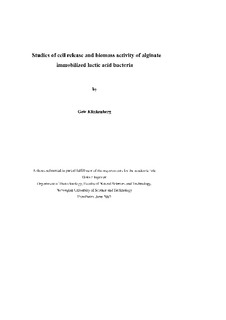| dc.contributor.author | Klinkenberg, Geir | nb_NO |
| dc.date.accessioned | 2014-12-19T13:14:10Z | |
| dc.date.available | 2014-12-19T13:14:10Z | |
| dc.date.created | 2002-07-09 | nb_NO |
| dc.date.issued | 2002 | nb_NO |
| dc.identifier | 126343 | nb_NO |
| dc.identifier.isbn | 82-471-5472-2 | nb_NO |
| dc.identifier.uri | http://hdl.handle.net/11250/245592 | |
| dc.description.abstract | The scope of the work presented in this thesis has been the study of growth, cell release and metabolite production of gel-entrapped viable lactic acid bacteria. As these fermenation systems are mainly aimed at food applications, immobilization methods based on alginate and chitosan were chosen due to the biocompatibility of these materials. In these studies, ways to measure, characterize and influence the activity and release of the immobilized lactic acid bacteria were investigated.
The use of sequential coatings with chitosan (C) and alginate (A) on alginate beads immobilizing Lactococcus lactis ssp. lactis NCMIB 6681 was investigated. The effects of these coatings on biomass activity and cell release were evaluated in batch and continuous systems. In this work, and argument is made for the use of and experimental system based on continuous fermentation at a controlled pH and a high dilution rate for these types of studies. When examined in this system, chitosan coating alone seemed to reduce the ratio of cell release to lactate production in the early stages of fermentation, while sequential coatings with chitosan and alginate (CAC) showed significant reductions in this ratio throughout the whole 48 hour test period.
Under normal growth conditions, diffusional limitations direct most of the biomass growth in beads immobiizing lactic acid bacteria to the ooutermost parts of the beads. Therefore, a study was conducted in order to investigate if biomass distributions, and thereby cell release, could be affected through changes of the growth conditions. A change in operating pH from 6.5 to 9.25 initially reduced the ratios of rates of cell release to lactate production by almost a factor of 105. Compared to fermentations at pH 6.5, growth at pH 9.25 also increased the final internal bead biomass concentration by a factor of 5 and increased the final rate of lactate production by 25%. After 48 hours, the ratio of the rates of cell release to lactate production was still 10 times lower than in fermentaions at pH of 6.5. These data illustrate that diffusionsal limitations and corresponding pH-gradients can be exploited in affecting the distribution of immobilized growing cells and their concomitant release.
The use of sequential coatings with chitosan and alginate was investigated as a way to a reduced cell release during immobilized bacteriocin production. Production of the bacteriocins enterocins A and B by immobilized E.faecium CTC492 in uncoated and CAC-coated alginate beads was evaluated in batch and continuous ferminations. In batch fermenations with E. faecium CTC492 immobilized in CAC.coated beads substantial amount of the maximal bacteriocin activity in traditional free-cell fermentaion was obtained, combined with a more than 3 log unit reduction of the amount of free biomass in the product. Longer-term studies of bead performance were performed using continuous fermentaions at high dilution rates. These experiments showed the the use of CAC-coatings reduced the ratio of rates of bacteriocin production to cell release significantly the first 20 hours of fermentaion. In these studies, the presence of large pH gradients within beads containing immobilized E. facium CTC492 during continuos fermentation were demonstrated using a microelectrode. As expected, the bacteriocin production and fermination characteristics of immobilized E. faecium CTC492 seemed to be significantly influenced by the presence of these local pH-gradients. | nb_NO |
| dc.language | eng | nb_NO |
| dc.publisher | Fakultet for naturvitenskap og teknologi | nb_NO |
| dc.relation.ispartofseries | Dr. ingeniøravhandling, 0809-103X; 2002:74 | nb_NO |
| dc.relation.haspart | Klinkenberg, G; Lystad, K. Q; Levine, D. W; Dyrset, N. Cell Release from Alginate Immobilized Lactococcus lactis ssp. lactis in Chitosan and Alginate Coated Beads. Journal of Dairy Science. 84: 1118-1127, 2001. | nb_NO |
| dc.relation.haspart | Klinkenberg, G; Lystad, K. Q; Levine, D. W; Dyrset, N. pH-controlled cell release and biomass distribution of alginate-immobilized Lactococcus lactis subsp. lactis. Journal of Applied Microbiology. 91: 705-714, 2001. | nb_NO |
| dc.subject | Melkesyrebakterier | no_NO |
| dc.title | Studies of cell release and biomass activity of alginate immobilized lactic acid bacteria | nb_NO |
| dc.type | Doctoral thesis | nb_NO |
| dc.contributor.department | Norges teknisk-naturvitenskapelige universitet, Fakultet for naturvitenskap og teknologi, Institutt for bioteknologi | nb_NO |
| dc.description.degree | dr.ing. | nb_NO |
| dc.description.degree | dr.ing. | en_GB |
